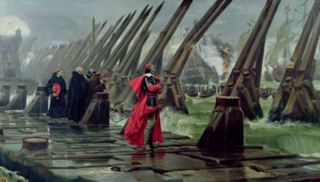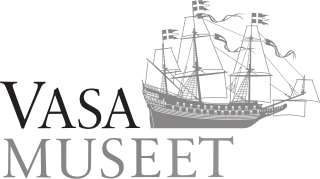
Vasa or Wasa is a Swedish warship built between 1626 and 1628. The ship sank after sailing roughly 1,300 m (1,400 yd) into her maiden voyage on 10 August 1628. She fell into obscurity after most of her valuable bronze cannons were salvaged in the 17th century, until she was located again in the late 1950s in a busy shipping area in Stockholm harbor. The ship was salvaged with a largely intact hull in 1961. She was housed in a temporary museum called Wasavarvet until 1988 and then moved permanently to the Vasa Museum in the Royal National City Park in Stockholm. The ship is one of Sweden's most popular tourist attractions and has been seen by over 35 million visitors since 1961. Since her recovery, Vasa has become a widely recognized symbol of the Swedish Empire.

The Siege of La Rochelle was a result of a war between the French royal forces of Louis XIII of France and the Huguenots of La Rochelle in 1627–1628. The siege marked the height of the struggle between the Catholics and the Protestants in France, and ended with a complete victory for King Louis XIII and the Catholics.

The Vasa Museum is a maritime museum in Stockholm, Sweden. Located on the island of Djurgården, the museum displays the only almost fully intact 17th-century ship that has ever been salvaged, the 64-gun warship Vasa that sank on her maiden voyage in 1628. The Vasa Museum opened in 1990 and, according to the official website, is the most visited museum in Scandinavia. Together with other museums such as the Stockholm Maritime Museum, it belongs to the Swedish National Maritime Museums (SNMM).

Kronan, also called Stora Kronan, was a Swedish warship that served as the flagship of the Swedish Navy in the Baltic Sea in the 1670s. When built, she was one of the largest seagoing vessels in the world. The construction of Kronan lasted from 1668 to 1672 and was delayed by difficulties with financing and conflicts between the shipwright Francis Sheldon and the Swedish admiralty. After four years of service, the ship sank in rough weather at the Battle of Öland on 1 June 1676: while making a sharp turn under too much sail she capsized, and the gunpowder magazine ignited and blew off most of the bow. Kronan sank quickly, taking about 800 men and more than 100 guns with her, along with valuable military equipment, weapons, personal items, and large quantities of silver and gold coins.

Król Dawid was a galleon of the Polish Navy that fought in the Battle of Oliwa. She was launched as König David 1623 in Danzig (Gdańsk) and initially served as a merchant ship.

Fredrik Henrik af Chapman was a Swedish shipbuilder, scientist and officer in the Swedish navy. He was also manager of the Karlskrona shipyard 1782–1793. Chapman is credited as the world's first person to apply scientific methods to shipbuilding and is considered to be the first naval architect.

Carl Gustaf Anders Franzén was a Swedish marine technician and an amateur naval archaeologist. He is most famous for having located the 1628 wreck of the Swedish galleon Vasa in 1956 and participated in her salvage 1959–1961. He also participated in the exploration for the wrecks of Swedish warships Kronan, Riksäpplet and Resande Man as well as Gustav Vasa's flagship Lybska Svan.

The Surveyor of the Navy also known as Department of the Surveyor of the Navy and originally known as Surveyor and Rigger of the Navy was a former principal commissioner and member of both the Navy Board from the inauguration of that body in 1546 until its abolition in 1832 and then a member Board of Admiralty from 1848 to 1859. In 1860 the office was renamed Controller of The Navy until 1869 when the office was merged with that of the Third Naval Lord's the post holder held overall responsibility for the design of British warships.

Laurens Reael was an employee of the Dutch East India Company, Governor-General of the Dutch East Indies from 1616 to 1619, and an admiral of the Dutch Republican Navy from 1625 to 1627.

Clas Larsson Fleming was a Swedish naval officer and nobleman involved in the development of a formal management structure for the Swedish Navy during the reigns of King Gustavus Adolphus and Christina, Queen of Sweden. He is remembered as one of the ablest administrators in the history of the Swedish Navy, and is in many ways a typical example of the type of aristocrat who served the Swedish Crown during the period of Sweden's imperial expansion.
Margareta i Kumla also known as the Sibyl of Kumla, or Kumlapigan, , was a Swedish visionary, who claimed to be possessed. She became the target of pilgrimages when claiming to be the channel of the words of the angels.

The Anglo-French War was a military conflict fought between the Kingdom of France and the Kingdom of England between 1627 and 1629. It mainly involved actions at sea. The centrepiece of the conflict was the siege of La Rochelle (1627–28), in which the English Crown supported the French Huguenots in their fight against the French royal forces of Louis XIII of France. La Rochelle had become the stronghold of the French Huguenots, under its own governance. It was the centre of Huguenot seapower and the strongest centre of resistance against the central government. The English also launched a campaign against France's new colony in North America which led to the capture of Quebec.

The Dalarö wreck is a shipwreck of a 17th-century ship lying in the waters off Edesön near Dalarö, southeast of Stockholm, Sweden. It is the remains of a three-masted armed vessel. It was discovered in 2003 but it was not made public until March 2007.
Benzelius is the surname of a Swedish family of pastors and theologians, which originated in Bensbyn in the municipality of Luleå, from which the surname was formed in Latin.
Vasa syndrome is a term used in both management and marketing circles referring to problems in communication and management affecting projects, sometimes causing them to fail. Its basis lies with the Swedish 17th-century warship Vasa, which sank on its maiden voyage because it was too unstable.

Arka Noego was a war pinnace in the Polish–Lithuanian Commonwealth Navy that played an important role in two naval battles of the Polish–Swedish War (1626–29). Small, fast and lightly armed when compared to the impressive man-of-war galleons of the Swedish Navy, excellent leadership, a fine crew and aggressive marines combined to bring the Arka Noego into parity with her larger opponents. Major roles in two impressive victories followed in the fall of 1627.

Events from the year 1628 in Sweden

Margareta Nilsdotter also called Margareta Hybertsson was a Swedish businessperson and shipbuilder. In 1627, she completed construction of the Swedish warship Vasa.

A Swedish Tiger is a 1948 Swedish war drama film directed by Gustaf Edgren and starring Edvin Adolphson, Erik Berglund and Margareta Fahlén. The film's sets were designed by the art director Nils Svenwall. Its title refers to the wartime propaganda campaign A Swedish Tiger encouraging inhabitants to avoid careless talk.

Äpplet was a Swedish warship built in the late 1620s as the sister ship of Vasa, intended as one of the largest and most prestigious ships in the Swedish navy under King Gustavus Adolphus. Äpplet was built in the same shipyard in Stockholm as Vasa but finished somewhat later and with different proportions. The reason for the different proportions was the replacement of the original shipwright Henrik Hybertsson who died in 1627 with Hein Jakobsson who also attempted to widen Vasa while it was being built. Äpplet was launched in 1629 less than year after the embarrassing loss of Vasa on its maiden voyage. The ship was not a great success but served as part of the escort for Swedish troops to Germany as part of the Thirty Years' War. Smaller ships were generally chosen by Admiral of the Realm since they were more maneuverable. In 1658, Äpplet was in poor condition and deemed too expensive to repair and was sunk outside Vaxholm to block one of the main inlets to the capital of Stockholm.
















